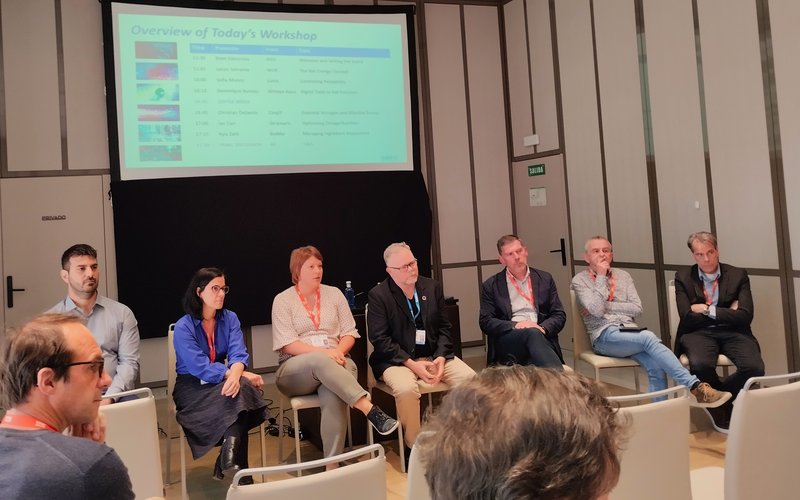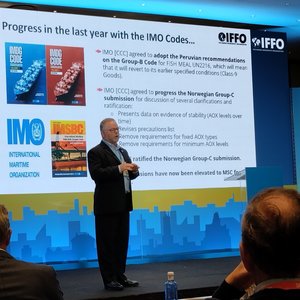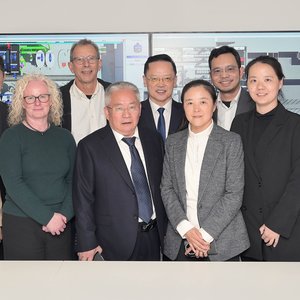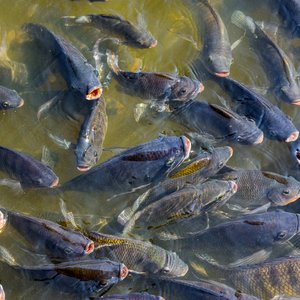Precision nutrition is the practice of providing animals with the right nutrients, in the right amounts, at the right time, based on their current and emerging physiological needs. These needs are not static; they vary with life stage, health status, genetics, temperature, and farming systems. Other factors, such as sustainability goals and end-product quality, further influence nutritional requirements over an animal’s life cycle. The ultimate goal is to match nutrient supply more precisely to these evolving demands. The practice was discussed during IFFO’s InFocus Workshop on Precision Nutrition for Aquaculture that took place during the 2025 IFFO Members’ Meeting in Madrid.
“The aquafeed industry has made significant progress in many aspects in recent years, but in the case of salmon, for example, we've reached a plateau, with feed conversion ratios (FCR) remaining at around 1.3 for two decades. This reflects diminishing returns, where the easy gains are exhausted. Precision nutrition is now essential to extract additional value from feed and enhance productivity,” said Brett Glencross, IFFO’s technical director.
Feed formulation is based on two key knowledge areas: understanding the animal's nutrient requirements and understanding the nutritional composition and behavior of ingredients. While animals require nutrients and energy, not ingredients per se, ingredients serve as the delivery vehicles for those essential nutrients. Requirements define what the animal needs; specifications are how those needs are met. Formulation is thus a balancing act, aligning specifications with available ingredients, managing risks, and considering constraints such as price.
Net energy
Macronutrients—protein, fat, and carbohydrates—provide energy, which can be measured as total digestible energy, metabolizable energy or net energy. Net energy is particularly valuable as it accounts for differences in the efficiency with which macronutrients are utilized, providing a clearer picture of the actual energy available for growth.
“While the net energy system is standard in pig nutrition and increasingly in poultry, it’s more complex for aquaculture due to the variety of species and farming conditions. But just like with land animals, using net energy helps achieve more precise formulations,” explained Johan Schrama from Wageningen University.
The net energy concept in aquaculture has led to the realization of the actual energy available from different nutrients (protein, fat, starch) within various ingredients. More importantly, it has been noted that this is not consistent across some species. “Some species like tilapia seem to use starch well, whereas others like snakehead, not so much. In the snakehead diet, for instance, wheat doesn’t contribute to the net energy system, as the fish appears unable to effectively use the energy from starch,” Schrama explained.
This evolution in thinking is changing how some nutritionists define requirements. “It’s not about the percentage of the diet anymore. It's about the actual amount of nutrient intake per unit of body weight per day. For example, instead of saying a fish needs 1.5% EPA and DHA in its diet, we should be saying it needs 250 mg per kg of body weight per day,” said Glencross.
“This mirrors how nutritional panels work for human food, which list Recommended Daily Intakes (RDI). Other animal nutrition sectors—pigs, poultry, and even humans—have adopted this model. Some of us have been advocating for this shift in aquaculture, but there is resistance. It is a harder concept to grasp than simple percentage-based formulations, but it is far more accurate. Nutrition doesn’t work in percentages; it works in grams consumed per day, per kilogram of body weight, to drive specific growth outcomes,” he explained.
Ultimately, adopting a precision nutrition approach tied to RDI-like models will demand better-trained nutritionists and a more detailed understanding of ingredients. But the return is a clearer roadmap for how specific nutrients drive animal performance.
“It becomes much easier to explain and justify performance outcomes, like how many grams of protein per day are needed to reach a growth target. It’s all measurable and traceable,” Glencross said.
A call to ensure accurate nutritional data
In precision nutrition feed formulation, formulators must first define their objectives, then understand the animals' nutritional requirements (set nutritional specifications), followed by characterizing ingredient composition, before they can optimize feed formulations to meet production goals. Afterward, feeds are manufactured and performance is monitored—a step that is often overlooked, noted Dominique Bureau, chief scientific officer & co-founder, Wittaya Aqua, Canada.
For many species, the academic knowledge base was still incomplete as recently as the 2010s. It was observed that animals' nutrient requirements typically decrease as they grow. Feeding in excess of these requirements leads to environmental pollution and financial waste. The development of the IAFFD.com database has provided estimated requirements for 41 species, available in ASNS version 10.0.
“We use a factorial modeling approach to estimate nutritional requirements. Based on this, we develop specific nutritional specifications. We are actively seeking feedback to ensure the values we recommend are accurate and realistic so we can continue refining them,” Bureau explained.
His company, Wittaya Aqua, has created a digital ecosystem that connects ingredients to feeds. This includes a raw material map, an economic valuation tool, a feed formulation platform, and production data management and analysis software—all designed to support feed manufacturers in advancing precision nutrition.
Current utilization of precision nutrition
Some Western feed companies have already adopted precision nutrition principles. One example is Cargill that launched its Essential Nitrogen Concept in 2021, which relies on the requirements of proteinogenic amino acids, not just essential amino acids, and splits nitrogen into two categories: essential nitrogen – that needed to drive a specific performance indicator – and non-essential nitrogen – supplied in excess as a byproduct of least cost formulation. The concept builds on the Ideal Protein Concept (IPC), which emphasizes balancing all essential amino acids relative to lysine and follows the Law of the Minimum – if even one essential nutrient is deficient, growth is compromised regardless of the availability of others.
“Increasing ideal protein boosts performance even without increasing digestible protein. Taking the concept further, amino acid profiles must be specifically developed. We should challenge what is essential and what is not essential. There might be specific requirements for amino acids in specific tissues, and we need to take this into account as an energy source,” said Christian De Santis, principal scientist at Cargill, during the workshop. In 2024, Cargill expanded on this with Effective Energy concept, a new bioenergetic model that incorporates the principles of essential nitrogen into a more holistic energy framework.
Regional challenges in Asia
In contrast, feed formulation in Asia has traditionally been conservative. “Many feed producers in the region treat feed more like a recipe than a formulation, and they have been difficult to persuade to change. That said, there has been some progress, particularly where technological awareness has increased. There is growing recognition that it is about nutrients, not just ingredients,” said Glencross.
Regulatory barriers further complicate matters. In countries like Thailand, outdated government mandates on nutrient levels, based on trials from the 1980s, continue to constrain innovation. “Thailand still mandates minimum protein levels, even though modern nutrition science shows we can vary protein and energy levels depending on life stage. For example, Asian seabass require over 50% protein early in life, but this can be reduced during grow-out. Instead of adjusting fat levels for energy, Thai feed producers often increase starch, which carnivorous species like seabass can’t effectively utilize, leading to poor growth,” Glencross explained.
Another significant hurdle is the lack of reliable digestibility data, particularly for locally sourced ingredients. This forces formulators to rely on outdated or inconsistent "book values." “You can measure crude protein or fat easily, but digestible values are harder to assess. If you are using consistent ingredients like soy concentrate or fishmeal, you can manage variability. But if you are sourcing from diverse, cost-driven markets, you introduce high variability. This means a 40% crude protein feed could deliver 35% or even just 30% digestible protein, drastically affecting growth,” Glencross said.
China, despite its scientific capacity, also illustrates the challenge of aligning research with practice. “China now imports roughly half of the world’s fishmeal. While the global average inclusion rate has dropped from 25% to 10% over the last two decades, in China, it has remained flat, between 5% and 10%. So, as production has scaled up, their fishmeal use has exploded, not because inclusion rates increased, but because formulations haven't changed,” said Glencross. “There’s world-class nutrition science happening in China, but it’s not being adopted effectively at the industry level.”
Future trends in precision nutrition
Glencross emphasized the need for better characterization of feed ingredients, particularly regarding variability and the factors that drive it. Real-time technologies like Near-Infrared (NIR) scanning could help measure digestibility of protein and amino acids in materials like fishmeal or soybean meal, but only if globally standardized calibrations are developed and implemented. This would enable truly flexible, batch-specific formulation, adapting feed design to seasonal and raw material variations.
Another critical factor is palatability. While marine ingredient production from byproducts is growing, it won’t keep pace with demand, leading to increasing reliance on grains, ingredients that many aquatic species find unpalatable. “We need objective ways to measure and standardize palatability so that less palatable ingredients like soy can be balanced with small additions of highly palatable ones like hydrolysates,” Glencross said.
“The so-called ‘magic’ of marine ingredients comes from the presence of chemo-stimulants—chemosensory active compounds naturally found in fishmeal and fish oil,” added Sofia Morais, aqua innovation team leader at Lucta. “When levels of marine ingredients drop too low, palatability suffers. Two solutions exist: specialty ingredients rich in chemo-stimulants, though subject to seasonal variability; and additives, which are more consistent.”
Looking ahead, digital technologies will be central to precision nutrition. “Nutritional models help predict requirements and define ideal specifications. But the future lies in big data, AI, digital twins, and real-time optimization. This will involve moving beyond just nutrient demands into the realm of metabolizable and net demands,” Glencross concluded.










